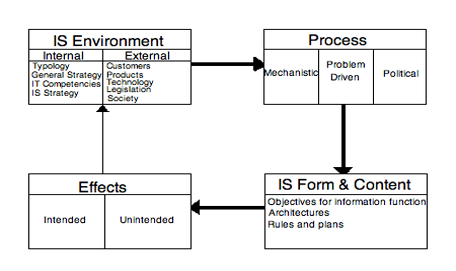Tool #12: Five-phase model to define the proper IS planning approach.
An overview of the five-phase model as adjusted by M.T. Smits and K.G. van der Poel.
This model defines the state of the Information Strategy of the organization. It can be seen as a continuous lifecycle of the Information Strategy of an organization, where each phase requires a different strategic approach.
This tool is developed to determine the current state of the organizational IT Strategy planning approach, which makes it possible to align the IS planning approach to the current state of the organization. This is important because when an IS Strategy is created without proper alignment the organization is likely to fail.
The five phases identified by M.T. Smits and K.G. van der Poel (1996) are:
Turbulence: A specific event arouses strategic interest in IT. Experimentation with new strategies.
Orientation: A new analysis of environment had been made, new goals are formulated and new methods of strategizing are tried.
Consolidation: Formed strategy gets approval of senior management and the new strategy is being laid out through the organization.
Exploration: Organization gets used to new strategy, and efficiency comes into focus; optimizing the procedures.
Tension: Shortcomings and missed opportunities arise and existing structure becomes inadequate.
These phases are identified by considering four “situational influences”. These can be seen as four different aspects which are interlinked as shown in the figure on the next page.
The four influences are:
1.IS Environment, where an analysis is made of the internal and external environment of the Information System.
2.Process, three types are distinguished: Mechanistic, Political and Problem Driven
3.IS Form and Plans, here is looked at the architecture and the layout of the IS
4.Effects, these are divided in intended and unintended effects of the Information Planning Strategy

Because of this linkage, organizations tend to move through the phases as the effects of the previous phase initiates the beginning of the next phase whilst the internal environment is changed.
To link the five phases to the four situational influences an overview is made of how the influences characterise each phase:
Organizational phase | |||||
Turbulence | Orientation | Consolidation | Exploitation | Tension | |
Environment Shock IT competencies IT awareness Process Process Type Methods/tools Top management Form and content Objectives Architectures Plans Effects Project level Bottom line | Current Seeking Very High Political / Problem driven No Very active Focus - Tentative Yes No | Recent Expanding High Political / Mechanistic Yes Active Established Experimental Flexible Yes No | - Expanding High Mechanistic Yes Supportive - Focus Firm Yes - | - Stable Low Mechanistic Customized Low - Stable Firm - Possibly | Imminent - - Problem driven No Growing - Outdated - - - |
When the current phase of the organization is identified one should align the approach for Information System planning with the correct phase.
By Sjoerd Borrius (S0141089)
